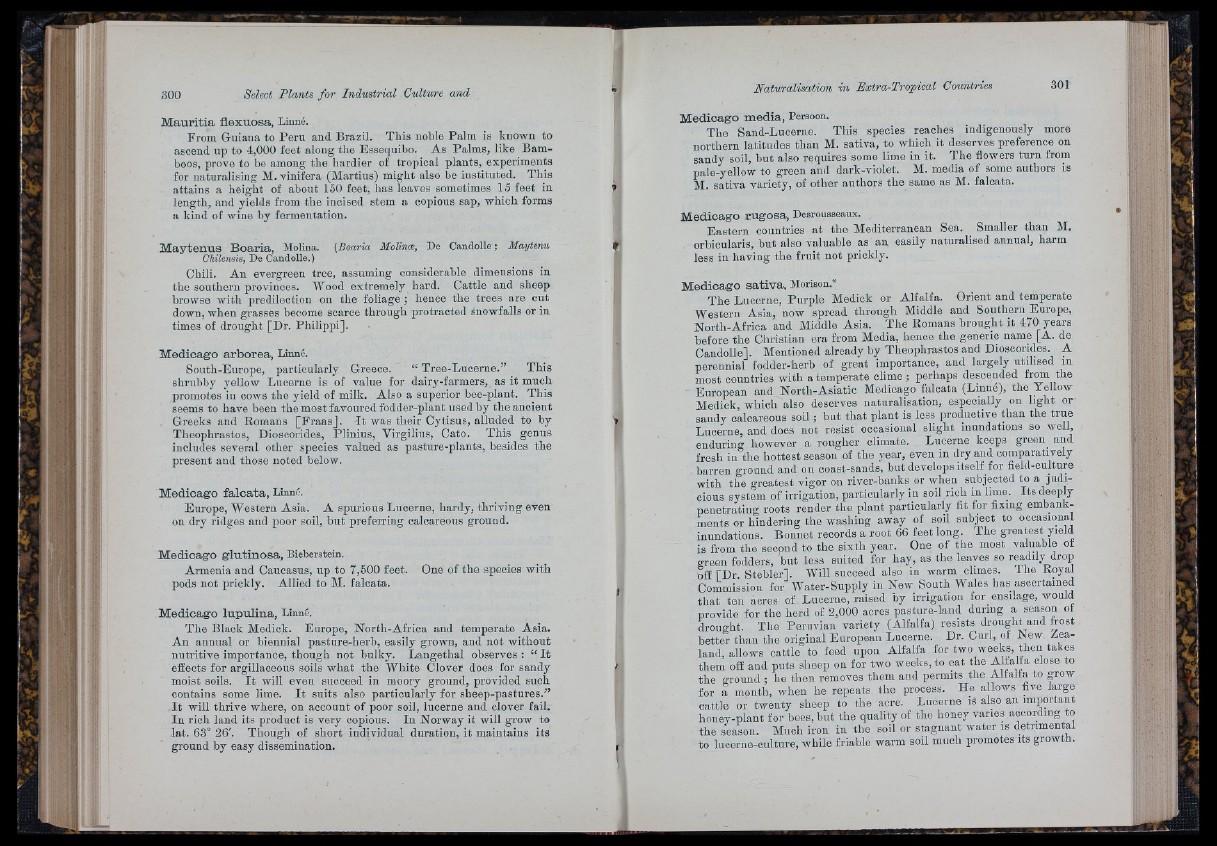
Select Plants fo r Industrial Culture and
M a u r itia fle x u o sa , Linné.
From Guiana to Peru and Brazil. This noble Palm is known to
ascend up to 4,000 feet along the Essequibo. As Palms, like Bamboos,
prove to be among the hardier of tropical plants, experiments
for naturalising M. viuifera (Martius) might also be instituted. This
attains a height of about 150 feet, has leaves sometimes 15 feet in
length, and yields from the incised stem a copious sap, which forms
a kind of wine by fermentation.
M a y te n u s B o a ria , Molina. (Boaria Molinoe, De Candolle ; Maytenu
Chilensis, De Candolle.)
Chili. An evergreen tree, assuming considerable dimensions in
the southern provinces. Wood extremely hard. Cattle and sheep
browse with predilection on the foliage ; hence the trees are cut
down, when grasses become scarce through protracted snowfalls or in
times of drought [Dr. Philippi].
I
); :>
■
' u.
' t
M ed ic ag o a rb o re a , Linné.
South-Europe, particularly Greece. “ Tree-Luoerne.” This
shrubby yellow Lucerne is of value for dairy-farmers, as it much
promotes in cows the yield of milk. Also a superior bee-plant. This
seems to have been the most favoured fodder-plant nsed by the ancient
Greeks and Eomans [F ra a s]. I t was their Cytisus, alluded to by
Theophrastos, Dioscorides, Plinius, Virgilius, Cato. This genus
includes several other species valued as pasture-plants, besides the
present and those noted below.
M e d ic a g o f a lc a ta , Linnc.
Europe, Western Asia. A spurious Lucerne, hardy, thriving even
on dry ridges and poor soil, but preferring calcareous ground.
M ed ic ag o g lu tin o s a , Bieberstein.
Armenia and Caucasus, up to 7,500 feet,
pods not prickly. Allied to M. falcata.
One of the species with
r : '
''•'i
M e d ic a g o lu p u lin a , Linné.
The Black Mediok. Europe, North-Africa and temperate Asia.
An annual or biennial pasture-herb, easily grown, and not without
nutritive importance, though not bulky. Langethal observes : “ I t
effects for argillaceous soils what the White Clover does for sandy
moist soils. I t will even succeed in moory ground, provided such
contains some lime. I t suits also particularly for sheep-pastures.”
I t will thrive where, on account of poor soil, lucerne and clover fail.
In rich land its product is very copious. In Norway it will grow to
lat. 63° 26'. Though of short individual duration, it maintains its
ground by easy dissemination.
M e d ic a g o m e d ia , Persoon.
The Sand-Luoerne. This species reaches indigenously more
northern latitudes than M. sativa, to which it deserves preference on
sandy soil, but also requires some lime in it. The flowers turn from
pale-yellow to green and dark-violet. M. media of some authors is
M. sativa variety, of other authors the same as M. falcata.
M e d ic a g o ru g o s a , Desrousseaux.
Eastern countries a t the Mediterranean Sea. Smaller than M.
orbicularis, but also valuable as an easily naturalised annual, harm
less in liaving the fruit not prickly.
M e d ic a g o s a tiv a , Morison.*
The Lucerne, Purple Medick or Alfalfa. Orient and temperate
Western Asia, now spread through Middle and Southern Europe,
North-Africa and Middle Asia. The Romans brought it 470 years
before the Christian era from Media, hence the generic name [A. de
Candolle]. Mentioned already by 'Theophrastos and Dioscorides. A
perennial fodder-herb of great importance, and largely utilised in
most countries with a temperate clime ; perhaps descended from the
European and North-Asiatic Medicago falcata (Linné), the Yellow
Medick, which also deserves naturalisation, especially on light or
sandy calcareous soil ; hu t that plant is less productive than the true
Lucerne, and does not resist occasional slight inundations so well,
enduring however a rougher climate. . Lucerne keeps green^ and
fresh in the hottest season of the year, even in dry and comparatively
barren ground and on coast-sands, hut develops itself for field-oulture
with the greatest vigor on river-banks or when subjected to a judicious
system of irrigation, particularly in soil rich in lime. Its deeply
penetrating roots render the plant particularly fit for fixing embankments
or hindering the washing away of soil subject to occasional
inundations. Bonnet records a root 66 feet long. The greatest yield
is from the second to the sixth year. One of the most valuable of
green fodders, 'but less suited for hay, as the leaves so readily drop
off [Dr. Stebler], Will succeed also in warm climes. Ih e Royal
Commission for Water-Supply in New^ South Wales has ascertained
th a t ten acres of Lucerne, raised by irrigation for ensilage, would
provide for the herd of 2,000 acres pasture-land during a season ot
drought. The Peruvian variety (Alfalfa) resists drought and frost
better than the original European Lucerne. Dr. Curl, of New Zealand,
allows cattle to feed upon Alfalfa for two weeks, then takes
them off and puts sheep on for two weeks, to eat the Alfalfa close to
the ground ; he then removes them and permits the Alfalfa to grow
for a month, when he repeats the process. He allows five large
cattle or twenty sheep to the acre. Lucerne iS also an important
honey-plant for bees, but the quality of the honey vanes according to
the season. Much iron in the soil or stagnant water is detrimental
to Incerne-culture, while friable warm soil much promotes its growth.
U